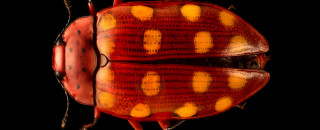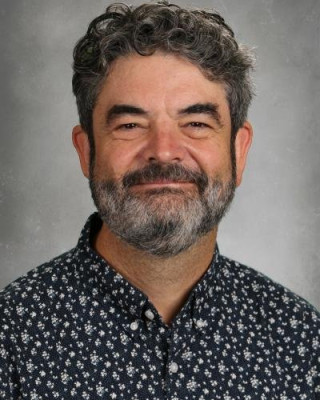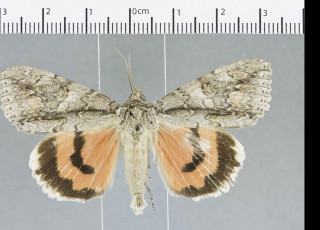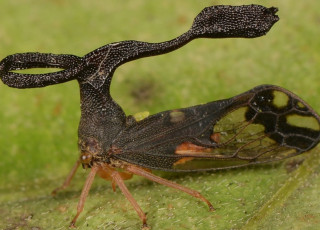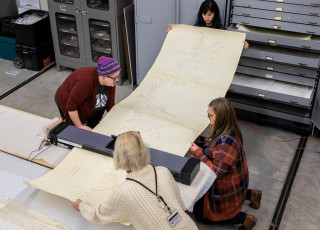The Insect Photography of Levon Biss
By Matt Pacenza
Imagine creating a portrait of a person by taking a picture of one hair at a time and you can begin to appreciate the extraordinary and innovative labors of Levon Biss, the British photographer whose massive-scale images of insects are currently on display at the Natural History Museum of Utah from now through September 15.
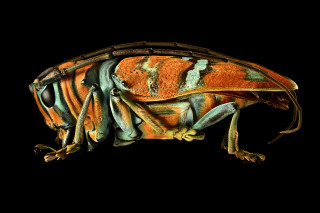
A Jewel Longhorned Beetle. Levon Biss
The images of 37 insects in the exhibit “Microsculpture: Inspect Portraits by Levon Biss” are as large as 9 feet tall, comprising 8,000 to 12,000 pictures stitched together.
Making the gorgeous, detailed images was hard work, but Biss hopes it educates and inspires young people to be better caretakers of Earth and its natural life. “We will be handing over this planet in a certain state,” he said in June during an interview from England. “So, the more we can give the generations to come the ability to appreciate insects and understand their importance, the better off we’ll be.”
The massive scale of the images -- revealing tiny ridges, indentations, hairs and other details that would be invisible at scale -- “captures your attention,” Biss notes. “And by capturing attention, you can educate. The importance of insects needs to be promoted. We can celebrate their beauty, their ingenuity.”
Photography buffs may wonder how Biss made these extraordinarily detailed and gorgeous images of often tiny insects. He describes the process -- which took four to six weeks per image -- in detail on his website.
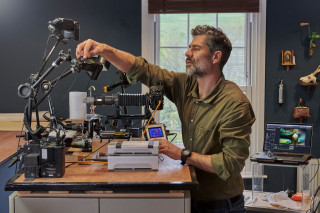
Photo provided by Levon Biss
That time frame was necessary, Biss says, because the high magnification photography and microscopic lenses he uses only captured a tiny slither of focus. All photographs have a specific area that a lens is perfectly focused on, but in photos as magnified as Biss shot, that area is minuscule. So much so that between each photo, the special equipment that Biss designed would move the camera just seven microns. How small is seven microns? The average human hair is 75 microns wide.
It’s painstaking work, Biss acknowledges. “You take the picture. You move forward, maybe seven microns. You take another picture, and again move seven microns and so on and so on all the way through.”
Some of that process is automated, but Biss would re-focus and re-light the specific region he was photographing that day -- let’s say, the insect’s eye -- before the equipment he designed would capture dozens of microscopic images.
That process would take several weeks -- as would post-production, when it came time to “squash all those thousands of images together” into one gorgeous final product. “It ends up being like a jigsaw puzzle,” Biss said.
Incredibly, Biss even took his meticulous macrophotography work on the road, out of his studio, to the Bolivian jungle where he shot the so-called zombie fungus (Cordyceps) for a David Attenborough documentary, “Our Planet.” (It’s currently available for streaming on Netflix.)
“It was a ridiculously hard job,” Biss says. “But it was worthwhile.” Biss shot a half million images of the fungus over 27 days -- and those ended up as 45 seconds of footage in the Attenborough documentary.
Several of the species that Biss photographed have stuck with him. One is the now-extinct Rocky Mountain Locust, a grasshopper species native to the American and Canadian West that was believed to have disappeared in the late 19th Century, because of human mining, plowing, and irrigation. He described it as “regal.”
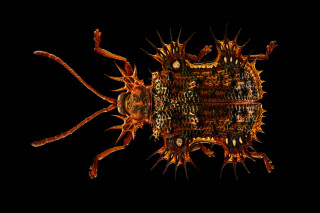
A Tortoise Beetle Levon Biss
Photographing the locust was “nerve-wracking,” Biss says, because of its extremely fragile wings. “I was quite looking forward to getting it back in its box as soon as possible. If anything happens, the opportunity to acquire another specimen isn't there.”
Another memorable insect Biss photographed is the Lord Howe Island Stick Insect, sometimes called the “tree lobster.” The insects, found only on a small group of islands off the eastern coast of Australia, were believed to be extinct before a few dozen members of the species were found in 2001 on a tiny rock outcropping in the Pacific.
Researchers captured several breeding pairs, and thanks to years of careful efforts from the Melbourne Zoo and other partners, thousands of the Lord Howe Island stick Insect are now flourishing both in captivity and the wild.
“It’s a great story,” Biss says. “Breeding programs do work. Extinction can be avoided.”
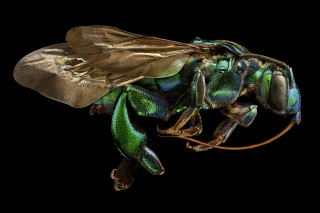
An Orchid Cuckoo Bee Levon Biss
Images of those two insects that Biss spoke about are not part of NHMU’s exhibit, but can be found on his website, “Extinct and Endangered: Insects in Peril.”
Part of the pleasure of visiting “Microsculpture” at NHMU goes beyond the sheer wonder of the images -- highlighted in a dark space that causes the insects’ bright colors to leap of the canvas -- is also the names of the insects that Biss photographed. Get ready to check out the Pleasing Fungus Beetle, the Amazonian Purple Warrior Scarab, the Flying Saucer Trench Beetle and the Assassin Beetle.
Beetles are the most common insects in “Microsculpture,” but also on exhibit are flies, wasps, weevils, moths, a butterfly and a treehopper.
Insects, especially ones without more fragile wings, can remain in their original condition for decades or even centuries. Another in Microsculpture is the Shield Bug. Who collected this particular insect? Charles Darwin in 1856. “It’s just as beautiful as it was the day he collected it,” Biss says.
Macrophotography of insects is only the most recent chapter in what has been an illustrious career for Biss, a 48-year-old born in London who now lives in the English countryside. For example, in 2005, he spent a year traveling the globe photographing the world’s love affair with football (aka soccer.) He visited 28 countries, and captured everything from the world’s best players on the pitch to children playing in the street and hot dog vendors hawking their wares outside stadiums. These images are collected in a book entitled, “One Love: Soccer for Life.”
“I’ve had some amazing experiences,” Biss says. But, once he had a family, he found himself drawn to work that would allow him to spend more time at home. “I needed something else to get me excited. I was shooting a lot of sports at the time and traveling the world but I wanted to try something new. And extreme macrophotography is definitely completely different.”
Biss says it took him a year to figure out how to even shoot the insects -- and about a decade to really perfect the process, which he has now extended from insects to other natural phenomena, such as seeds and fruits.
But, as has happened before, Biss says he’s now ready to move on to new challenges, and new subjects. He tends, he said, to find an area of work interesting for six to eight years -- and he’s about a dozen years into the macrophotography work. “So, at the moment, I'm just still trying to work out what that next project will be,” he says.
